

Norma Talmadge Productions/First National. Produced by Joseph M. Schenck. Directed by Fred Niblo. Screen story by Fred De Gresac. Adaptation-Scenario by Olga Printzlau and Chandler Sprague. Titles by George Marion, Jr. Photography by Oliver Marsh. Costumes: Alice O'Neill. Cast: Norma Talmadge, Gilbert Roland, Lilyan Tashman, Rose Dione Oscar Beregi, Harvey Clark, Helen Jerome Eddy, Alec B. Francis, Albert Conti, Michael Visaroff, Evelyn Selbie, Etta Lee, Maurice Costello. 9 reels. Douris Corporation has three double reels (35mm., 4,878 feet, story complete, some deterioration), an a video copy of this is available at the New York Public Library, Donnell Media Center. Clips are available from Archive Films.
See also a Lantern Slide advertising this film from the collection at the Cleveland Public Library
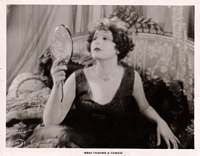 |
Picture with a snipe on the back from Derek Boothroyd |  |
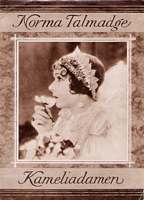 |
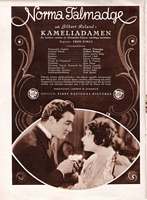 |
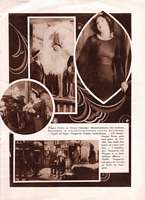 |
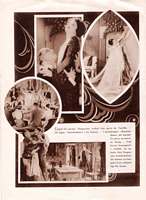 |
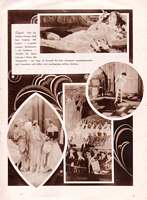 |
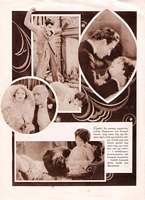 |
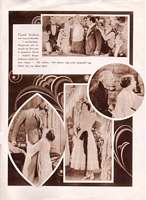 |
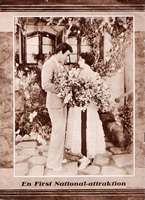 |
First National release of Joseph M. Schenck presentation. Norma Talmadge starred. Gilbert Rowland featured and Fred Niblo director. Photographed by Oliver Marsh. At the Globe, New York, for a run beginning April 21. Running time, 96 min. $2.30 top.
| Camille | Norma Talmadge |
| Armand | Gilbert Rowland [sic] |
| Olympe | Lylian Tashman |
| M. Duval | Maurice Costello |
| The Baron | Harvey Clark |
| The Duke | Alec B. Francis |
A high-rate program release. It's doubtful if even First National believes "Camille" can stand up as a $2 showing for any length of time.
Norma Talmadge never looked better in her life and the picture is an excellent technical example of photography and production. But to be a $2 attraction a picture must be vital. There's nothing vital about this latest version of the Dumas story.
Heavy interiors, gowns, etc., give the film an abundance of class, and the romance of the theme may get under the skins of the minority. Romantic tales are evidently riding the crest, taking "Flesh and the Devil" and "A Night of Love" as examples. "Camille" has a chance to follow up if released fast enough to be included on the incoming or maybe outgoing tide. Otherwise, Fred Niblo and Miss Talmadge had dedicated a pretty love story to the screen that lacks the punch to make it a standout.
As running at the Globe, in two halves, dramatic intensity only twice arises to make an audience forget it is watching a picture. This is when Armand returns to his suburban cottage to find Camille has left him, and when he next meets her in a gambling parlor escorted by her first financial amour, the Baron.
For some reason, Niblo omitted the traditional sympathy that goes with Camille's death or a pull on the heart strings where she gives up Armand at the instigation of his father. For a demi-mondaine supposedly in the throes of the first and only real love of her life, Miss Talmadge gives in much too easily as Niblo has screened it.
In these times when hotsy-totsy film fare is splashed across the screen in unmistakable gestures, Camille's quick and well-nigh emotionless acceptance of the pater's demands is very apt to leave an audience cold. And that also goes for the aftermath of her asking for the older man to kiss her as a daughter. No thrill there, either. The picture has a tendency to miss where it should grip.
And through it all Miss Talmadge looks beautiful. Never better, besides giving a sterling performance. This probably will be of decisive aid to the picture. It needs it.
Opposite Miss Talmadge is Gilbert Rowland. Fandom in general is liable to tab these two as a "cute" screen couple. That being so, it'll be enough. If they like this pair together "Camille" is going to do business in the regular program houses. For $2 it hasn't the stamina to stand up as full and satisfying entertainment.
Other than Miss Talmadge and Mr. Rowland no one shines except Harvey Clark. The latter does adequately, too, especially in his scene with Rowland when both men are at white heat over a gambling table, with Camille as the undertow that is dragging on their nerves. Beyond that nobody will ever know that Lilyan Tashman is in the picture and the couple of hundred feet which include Alec Francis will never mean anything to him. The same for Maurice Costello.
Eye-filling sets and Miss Talmadge. That seems to have been the formula followed. Both are sufficient for program needs.
Niblo's direction includes a couple of new camera tricks. During the sequence of Armand's anguish over Camille's desertion the boy's mental agony is brought out by a series of dissolved bringing his face closer and closer to the lens until he completely fills the screen, the finish of this string going back to a three quarter shot of the figure to pick up the action. The dissolve chain has a tendency to kill off the dramatic interest, but it is a new angle and worthy if not overly prolonged.
Another is the symbolism of night life by feminine limbs "shot" from between steps in a long stairway so that the effect is of women walking over the camera as they ascent. A new twist to the train covering the camera bit, and effective.
The picture is split into two parts, running 50 and 46 minutes respectively. How close this version adheres to the original story is problematical, although Chandler Sprague's continuity keeps this conception together nicely.
As a starter Camille is driven from her home into the arms of a wealthy admirer by parental cruelty. When meeting Armand she has tramped many a mile on the primrose path. Her adoption of the rose for the lily, as signified by Niblo, takes quite a while in the telling, although not so her surrender to Armand. This makes for inconsistency, but by stretching a point may be included under dramatic license.
The two throbs in the unreeling belong to Rowland. That doesn't mean that he steals the picture, for otherwise he would been smothered by Miss Talmadge. Camille's death is insignificant and will likely leave a house unmoved. Yet Miss Talmadge never loosens he hold on massed attention so long as she is on the screen.
Narration is through Armand reading the diary of his deceased love after she appears to him in a vision. So they know Camille is dead before the picture has gone 500 feet. Even if the story is so familiar as to be traditional, this is going to hurt.
You may not believe the story, but you'll believe Miss Talmadge's performance.
Appearing in "The Movies Are": Carl Sandburg's Film Reviews and Essays, 1920-1928, edited by Arnie Bernstein (courtesy of the publisher)
Camille has resumed its place on the Roosevelt Theater screen and is again attracting admirers of Norma Talmadge, other fans who are curious to see the new lover of the screen, Gilbert Roland, and still others who remember the play is one of the greatest love stories of literature and wish to see it again, even though it be a modern version and savors little of the illustrious past. It is beautifully costumed, exquisitely set and well photographed. More luxurious and tasteful mountings can scarcely be imagined. Certainly the surroundings of the famous actresses who played the Lady of the Camellias on the stage were never so costly. Fancy Clara Morris or even Sarah Bernhardt as handsomely arrayed, but then-neither were the lilies of the field. Gilbert Roland is a handsome and fiery Armand and may be the longed-for successor to Rudolph Valentino or at least a worthy rival to John Gilbert. Time and the taste of film fans must decide. It is not likely that a more beautiful Camille or a sweeter one will love than Norma Talmadge. That she is not the Camille of the Dumas story is generally agreed; not the wanton, ardent, self-forgetting, gay and irresistible Camille. But she is a charming actress and the picture is worth seeing.
Original comments, early 2000s
The good news is that Camille is not lost, as is often reported. The bad news is that it survives in a roughly condensed version, with many scenes showing noticable deterioration or printed very dark. It plays like a Reader's Digest version, with obvious bridging titles in a diffeerent typeface moving the story along until the next big scene. Sadly, the film will probably never be widely screened or make it to video on its own given its condition, though it would make a wonderful DVD extra.
This is doubly unfortunate, as the remaining scenes show that it was a distinguished film. Talmadge gives her usual excellent performance, though, as critics pointed out (see above), she doesn't put up much struggle against Armand's father. Her old Vitagraph co-star, Maurice Costello, is unusually sympathetic in that thankless part. Frances Marion recalled being fired from the film by Schenck for producing a screenplay insufficiently passionate. Olga Prinzlau ended up with the screenplay credit, but the passion problem seems to have been solved by the casting of Gilbert Roland. He is very good as a high-strung and sensitive Armand. He is also unbelievably handsome and he and Talmadge have a particular rapport onscreen.
The underrated director Fred Niblo included some interesting touches (though one also jumps to the conclusion that he was a "leg man"). One suspects that the whole was more than the sum of its remaining parts. The story was supposed to be framed by Armand's appearance at her deathbed, as in the book. But since the opening sequence was amongst those cut, its reappearance at the end is rather disorienting and takes away from the power of the ending.
Print viewed: video transfer of the surviving material from the Douris Corporation.
A one-reel fragment of the above print was showed at Pordenone, covering the part of the story where Armand finally meets Camille at her party and she gives him the camellia as an invitation to return. The program notes identified the source print that i viewed so long ago as a work print, which would explain a lot about its choppiness and poor printing. This was one of the better looking reels. Norma looked lovely but the Pordenone audience SWOONED over Gilbert Roland. There was an audible gasp when he came onscreen. Sad that the remains of the picture are in such poor condition, as the segment we were shown was quite enjoyable.
Last revised, May 2, 2009December 28, 2022